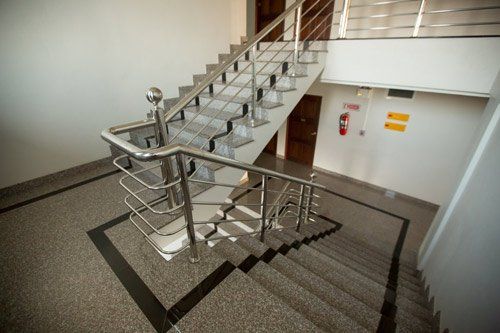If you want a balcony, stairway, or ramp for your home, then you have to consider railing as well. You may need handrails, guardrails, or a combination of both. Here is a look at what you should know about handrails and guardrails for your home's outside features.
Handrails are for hands, and guardrails are for bodies. Handrails help people navigate or climb an obstacle while standing up. Guardrails protect somebody from a fall.
You will often see handrails on features that require someone to stay steady, like along stairs. You can find guardrails on features that present a falling hazard, such as on a raised deck or balcony.
Sometimes people use the two terms interchangeably. For example, some handrails can work as a guardrail, and a guardrail can have a handrail attached.
Most building codes adhere to the ICC standards. No matter what, you must know what your local building codes say on the issue.
Even though the ICC gives a standard, building codes can vary by state and county. Even within the same county, some differences to building codes can exist depending on the precise location of your home or restrictions from an HOA.
You can look for building codes by state and county online. Make sure you narrow your search by looking specifically for handrail and guardrail statutes. You can also ask a local railing service. In most cases, some general requirements will apply across the board.
General Handrail Requirements
Handrails become necessary when you have four or more risers for stairs. The rail must run the length of the stairs. This also applies to inclines and ramps. Handrails are about the human motion of climbing, so any feature that requires a climb may also require a handrail.
General Guardrail Requirements
Guardrails are all about height. If you have an open landing that sits at least 30 inches above grade or the ground, you need guardrail. The railing requires precise construction to ensure safety.
Guards are common on balconies, decks, second-floor landings, or any place with a risk of injury from a fall. Even stairs can require a guard if the stairs climb too high, or if the stairs have an open side. In such a case, you will need both types of railing.
Understand you don't need permission to add railing to a feature. Even when the law doesn't require railing, you can still add it for your own peace of mind.
Both hand and guardrails can serve functions beyond safety. Railing can complement an outside feature, add value to your home, and highlight parts of your property you're proud of.
For example, you can use guardrails to enclose a porch or patio to keep it safe. However, that doesn't mean you can't use elegant iron railing to add a level of sophistication to the overall look of your home.
Railing also works as a way to keep pets and children away from any opening to the outside without fully blocking off a window or door. Juliet balconies or balconettes perform this service well and look good while doing so.
Choosing the right railing for your needs is important. If you're required to install railing, then the railing needs proper installation that fills all legal requirements. If you add railing for your own reasons, you still want the installation to adhere to professional industry standards.
At Capitol City Iron Works, we have the experience to help you choose and install the right railing for your outdoor features.
Contact us today for an estimate.









